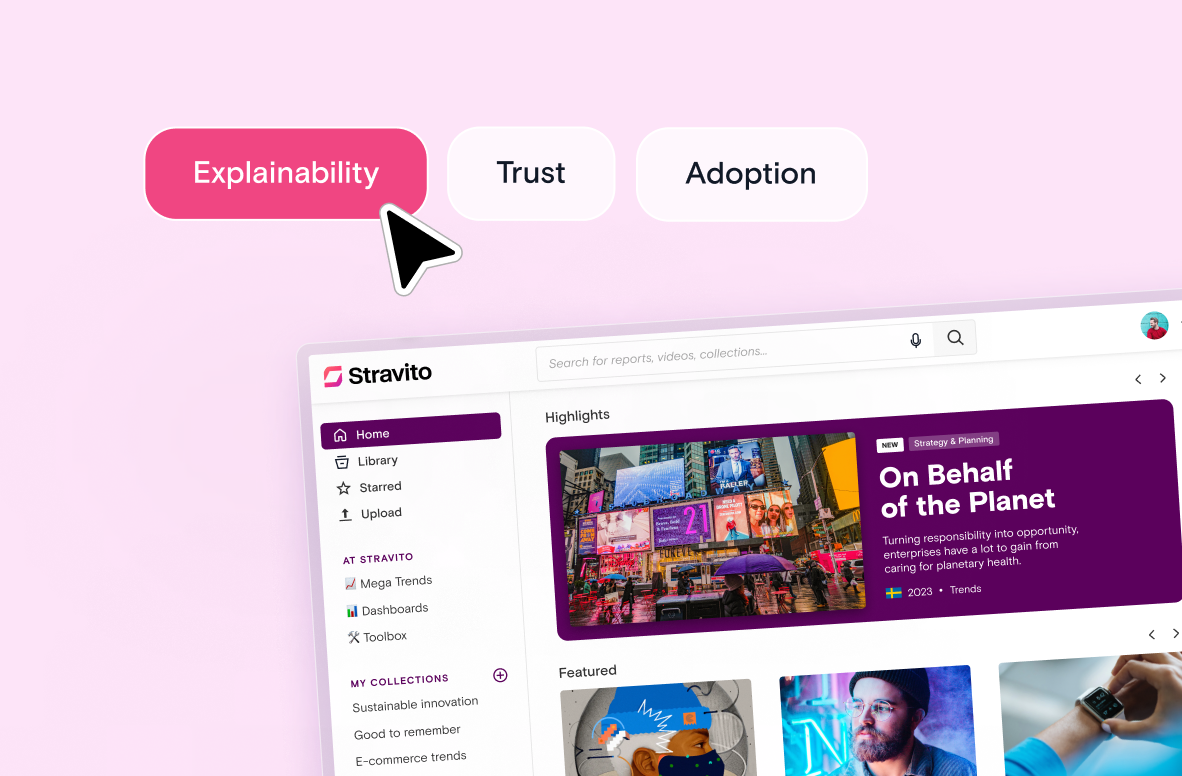There are many different types of knowledge, and they often come together to form something larger than themselves. From the music we listen to, the apps we use, the clothes we wear, the homes we live in, the exchange of knowledge and ideas has made it possible.
Knowledge sharing is an integral part of the human experience, as it facilitates our collective intelligence and thus progress as a society. By building on each other’s ideas, we are able to create more innovative solutions to problems, in every aspect of our lives. But in order to build, we have to have access to knowledge in the first place.
What is knowledge sharing?
In its broadest sense, knowledge sharing is exactly what it sounds like: the sharing of knowledge.
However, depending on the context, knowledge sharing can be defined in a variety of different ways. But to keep it simple, we’ll use Slack’s definition:
Knowledge sharing: the exchange of information across an organization
Of course, knowledge sharing is not nearly as simple as its definition suggests. So let's dig into it a bit deeper.
Knowledge sharing in organizations
Knowledge sharing is what makes the everyday activities of a business possible – from details about financial transactions, to plans and strategies, to the insights and research used to inform decisions. In order for the business to function properly, the right information needs to get to the right people at the right time.
But of course, not all knowledge is created equally. Some information is explicit and neatly packaged (like an invoice or a calendar invite). Other times, knowledge can be tacit and more abstract, drawing from experience (like how to handle an unexpected negative social media response to an ad campaign).
And then there is also knowledge that falls somewhere in between, like a market research report. Packaged as a document or slide deck, the content itself might not be structured in a way that’s easy to digest, and interpretations about how to proceed can differ depending on who is reading it.
In order for this type of knowledge to create value, not only does it need to get to the right person at the right time, it also needs to be packaged in a way that makes it easy to absorb and interpret correctly. That’s why it’s so important to understand the 5 Dimensions of Knowledge Sharing.
The 5 Dimensions of Knowledge Sharing
For a concept with such a straightforward definition, getting knowledge sharing right can be surprisingly difficult, especially on the organizational level. There are several variables involved, and the larger the organization, the more complex these variables can become.
In this section, we’ll look at 5 key dimensions of knowledge sharing on the organizational level. Breaking down knowledge sharing in this way will help to shine a light on what is required to make knowledge sharing work and where obstacles can emerge.
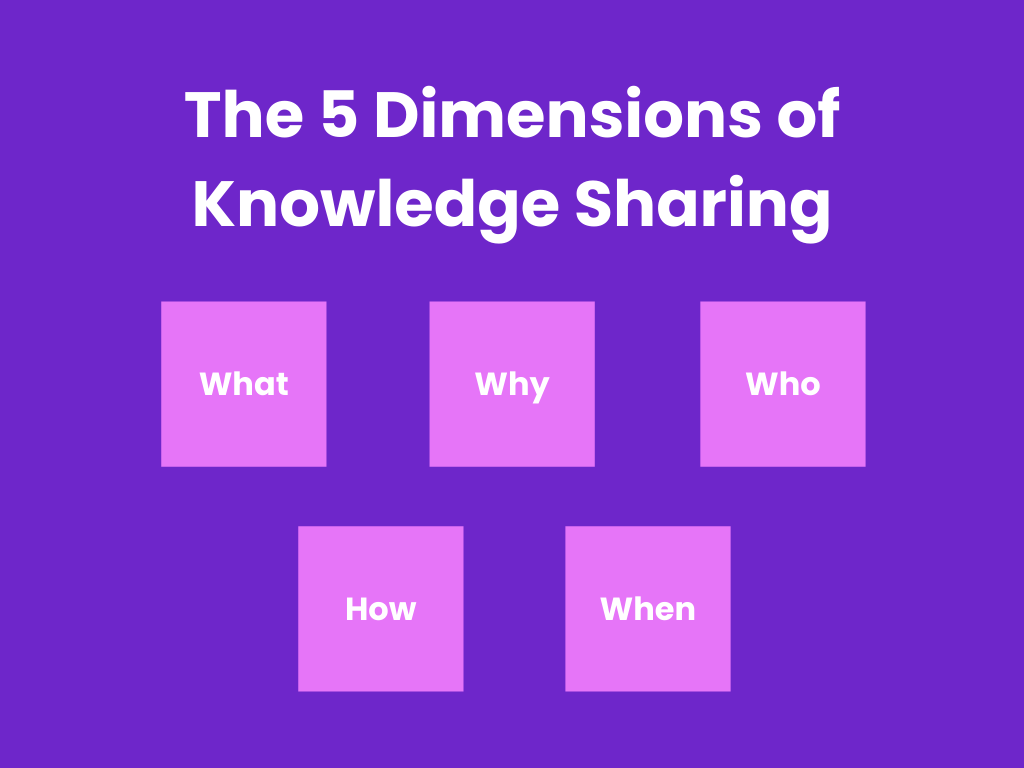
Dimension #1: What
Earlier, we discussed different kinds of work knowledge. Some of it is explicit and neatly packaged (like invoices and calendar invites), some of it is tacit and harder to encapsulate (like how to lead a team through a crisis), and some of it might be packaged but still unstructured, making it more challenging to sift through and absorb (like market research and insights).
What you’re sharing determines who you will share it with, why you are sharing it with them, how you can share it with them, and when you share it with them.
Dimension #2: Why
Next we have the why. Why is a certain piece of knowledge being shared? What is the intended effect?
For example, on a basic level, invoices are shared so that they can be paid. Experiences are shared to help others learn. Market research and insights are shared to shape decision-making.
From a business perspective, the why of knowledge sharing is absolutely crucial. Without a clear purpose, knowledge sharing just adds to the noise, losing its positive impact. Because it’s not the act of sharing that ultimately matters; it’s how that information is applied.
Dimension #3: Who
When looking at knowledge sharing, there are 2 primary roles: those who share knowledge and those who receive it. These roles are far from fixed, however, and most people will play both roles in a variety of different situations.
Understanding the Who of knowledge sharing is important because it determines key details about how knowledge can best be shared and received. For example, it can help to provide answers to questions such as:
- How much time does each role have?
- What are their top priorities?
- What other responsibilities are on their plate?
Which brings us to the How.
Dimension #4: How
The way knowledge is shared has a huge impact on whether it reaches the right stakeholders and has the desired impact.
Some knowledge is best shared directly with a specific individual, especially if action is required or the knowledge is of a particularly sensitive nature. In this situation, sharing a file directly with someone via email or messaging can make sense.
But there is also knowledge that is important for multiple stakeholders or the whole organization.
For example, a report that explores consumer preferences might answer a question for the marketing team, but can also provide the product team with valuable insight. In these situations, it’s essential to consider the most effective way to share knowledge with all of the right people.
Dimension #5: When
But you can’t forget that it’s not just about sharing knowledge with all the right people; it’s about sharing it with them at the right time as well. Timing is a crucial variable in knowledge sharing because it heavily influences how impactful the knowledge can be.
This can be because the knowledge itself is time-sensitive. For example, research conducted on a sudden change in consumer behavior in relation to a specific current event can quickly become less relevant. A timely business response is crucial to make the most of an opportunity or to mitigate negative outcomes.
But the When can also refer to when knowledge is factored into the individual or team decision-making process. Too early, and it risks being forgotten. Too late, and there might not be time or interest in revisiting previous stages of a project.
Working with the 5 Dimensions of Knowledge Sharing
Breaking down knowledge sharing by looking at these 5 key dimensions makes it a bit easier to illustrate the complexity of knowledge sharing on an organizational level.
Understanding this complexity is very helpful when you’re creating a knowledge sharing strategy from scratch or when you’re seeking to improve the existing ways your organization shares knowledge.
In the next section, we’ll explore why knowledge sharing is important and highlight some of the benefits that come with getting it right.
Why knowledge sharing is important
Knowledge sharing is regarded as being the most important aspect of knowledge management. It touches every part of the knowledge management process: capturing, distributing, and effectively using.
If knowledge isn’t shared enough, then knowledge silos are likely to develop in the organization. This can slow production, raise costs, and prevent meaningful collaboration.
But if knowledge is shared constantly without strategy or structure, problems with information overload can arise, which can create similar consequences.
Thus, effective knowledge sharing is a balancing act. It can be challenging to get it right on an organizational level, but taking the time to create a thoughtful knowledge sharing strategy is well worth it.
The benefits of knowledge sharing
Building a culture of knowledge sharing isn’t easy, and deciding whether or not to prioritize that effort against a variety of other essential initiatives can be tough.
In earlier stages, understanding some of the benefits associated with knowledge sharing can help guide your organization’s priorities. And in later stages, communicating the benefits associated with knowledge sharing can help to boost buy-in when implementing new processes or tools.
Benefit #1: Improved collaboration
Effective collaboration can be challenging, especially if no one is on the same page. Continuous knowledge sharing solves this issue, ensuring that teams across the organization are regularly updated on the most important insights. This helps to reduce the number of misunderstandings, while also enhancing the quality of meetings. Instead of taking 30 minutes to get everyone informed, that time can be spent discussing how to best apply the relevant knowledge.
Benefit #2: Enhanced productivity & faster decision making
Smoother collaboration means more productive collaboration. Better decisions can be made more quickly, ensuring that your organization is able to respond effectively to tough problems. Effective knowledge sharing can also enhance productivity on the individual level, by ensuring that everyone knows where to look for the information they need.
Benefit #3: Minimized organizational memory loss
Knowledge that isn’t shared is knowledge that can easily be lost. This can be because it gets forgotten (we’re all human!). It can also be because people leave the organization, sometimes taking decades of valuable knowledge with them. Sharing knowledge, especially market research and consumer insights, can help increase their longevity within the organization.
Benefit #4: Getting more value from existing knowledge
In large, decentralized organizations, several teams might have the same questions. Knowledge sharing makes it possible to reuse information in new contexts. This can mean that the same knowledge is applied in a new setting, completely eliminating the need to conduct new research. Or it can help to guide new research, ensuring that the same research questions aren’t repeated.
Benefit #5: Making it easier to practice consumer centricity
Practicing consumer centricity requires teams across the organization to have a deep understanding of consumers. Knowledge sharing is key to making this happen, allowing each team to apply consumer knowledge in combination with their unique expertise. Empowering employees with insights across the value chain, from customer service and marketing, to product and R&D, ensures that consumers remain at the heart of all decisions.
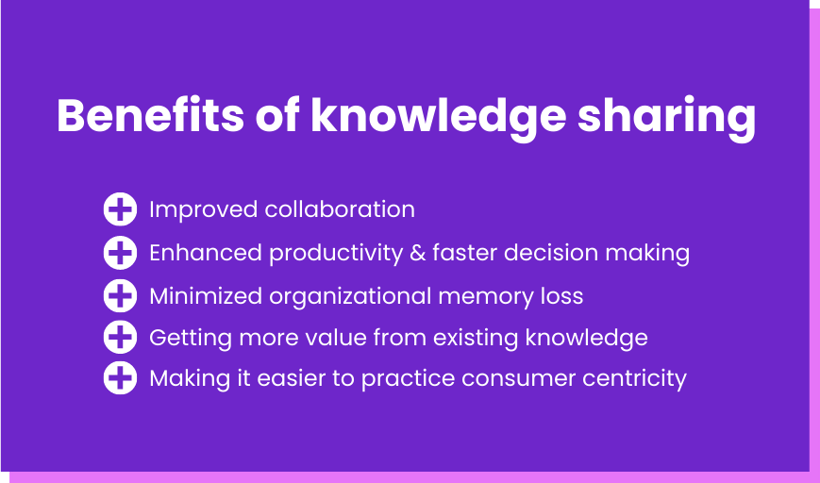
Knowledge sharing strategies
Now that we’ve covered what knowledge sharing is, why it’s important, and some of its key benefits, we’ll look into some practical strategies for actually making it happen.
Previously, we broke down knowledge sharing a bit further by looking at the 5 Dimensions: What, Why, Who, How, and When. In this section, we’re going to apply that thinking to explore different types of knowledge sharing methods and strategies.
How to apply methods for sharing knowledge
The 5 Dimensions are very helpful when assessing different methods of knowledge sharing. To illustrate, we’ll look at the fictional example of Company X. Let’s say that their dimensions look like this:
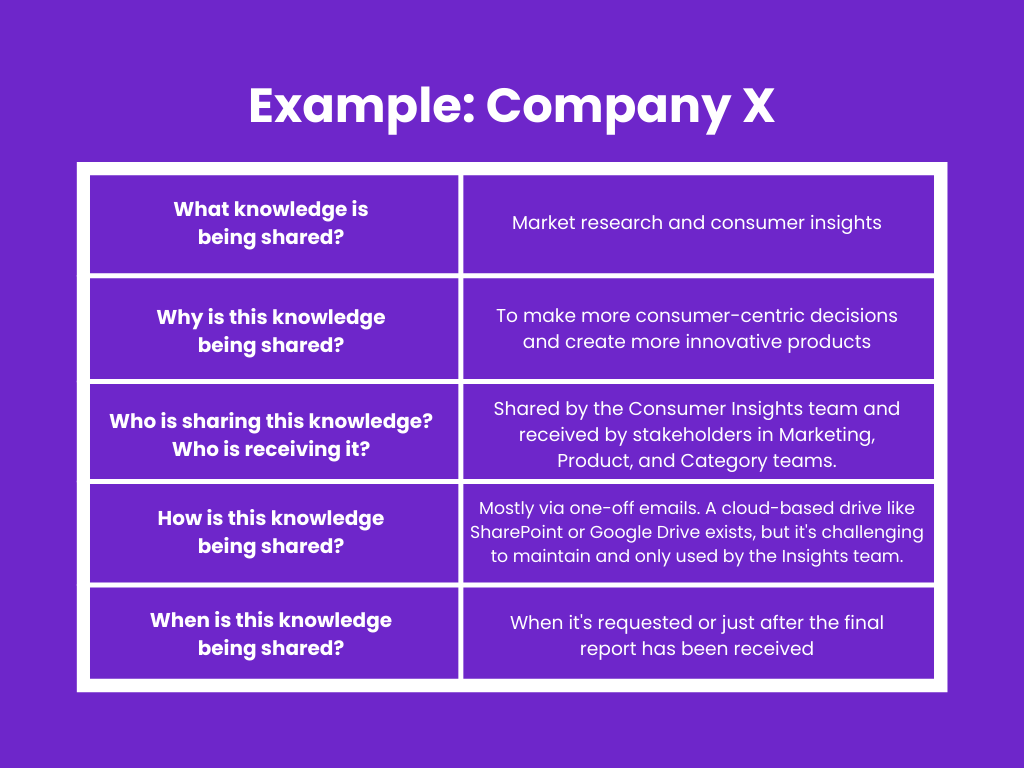
Now, in this example, we see that the knowledge sharing is primarily 1) direct, 2) one-off, and 3) to limited audiences. While these methods are great in some circumstances, relying exclusively on them can create some challenges and missed opportunities. Let’s dig into these a bit further.
Direct vs. Indirect knowledge sharing
In the example above, the knowledge sharing is direct in that it’s shared by the Consumer Insights managers when it is requested, and it’s on the Consumer Insights team to answer these requests. While they do have a repository for their insights, it isn’t really user-friendly for the Insights team and not readily accessible to organizational stakeholders.
The challenge in this situation is that relying exclusively on this type of direct knowledge sharing can create a lot of work for the people involved, especially for those who are responsible for sharing the information.
One way to address this is by introducing some indirect methods of knowledge sharing. For example, a more user-friendly repository that enables self-service access to knowledge and insights would reduce the workload placed on the consumer insights team. While they would still need to ensure that reports were uploaded to the repository, they would only need to do that once for stakeholders to be able to access relevant insights whenever they need them.
One-off vs. Continuous knowledge sharing
Another key characteristic of our Company X example is that the majority of knowledge sharing is one-off and by-request. This can be the most effective way to answer highly specific or sensitive research questions.
However, getting the right balance of one-off and continuous knowledge sharing is essential. If all knowledge sharing is continuous, then the risk of information overload for stakeholders increases. On the flip side, if all knowledge sharing is one-off, then it’s likely that requests get repetitive and can eat into the insights team’s time unnecessarily.
Creating channels for continuous knowledge sharing can help to reduce the volume of one-off requests, while also ensuring that consumer insights are always top-of-mind. This can be a major boost for consumer centricity initiatives, onboarding of new hires, as well as optimize the use of insights throughout large, decentralized organizations.
Limited audiences vs. Broader audiences
This last point builds on the two previous points. Because the majority of knowledge sharing at Company X is by-request and one-off, it also only ends up being shared with the stakeholders who asked for the information.
But as we’ve discussed, it’s likely in a lot of cases that other stakeholders have the same questions or would be able to take inspiration from the questions of others. That’s why pairing continuous knowledge sharing methods with sharing to broader audiences in the organization can help to make the most of valuable insights.
Of course, it’s still important to keep relevancy in mind. Everyone doesn’t want or need to see everything. As with the other aspects of knowledge sharing, determining audience size is a balancing act.
How to boost knowledge sharing at your organization
In the last section, we used the 5 Dimensions framework to analyze knowledge sharing at Company X. This illustrated what was working with their knowledge sharing practices, as well as areas where they could improve. It also highlighted how much work it can be to optimize knowledge sharing.
That’s why it can be helpful to evaluate your organization’s current knowledge sharing practices in order to better target any interventions. Below, we’ll go through a 3-step process you can use.
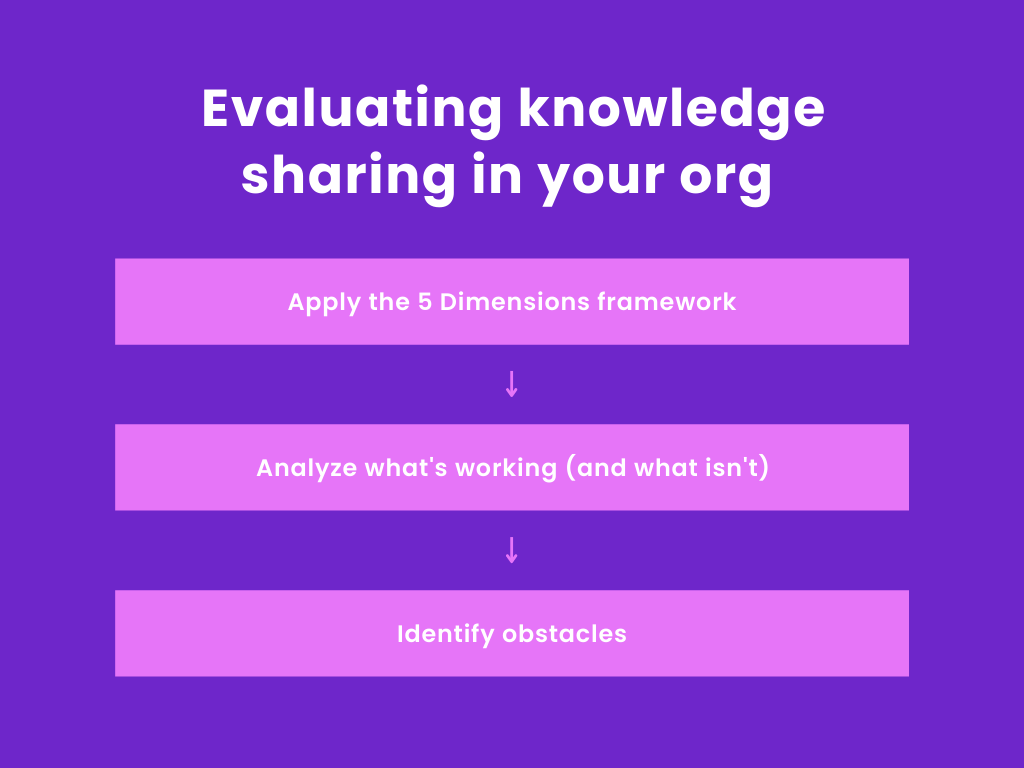
Step #1: Apply the 5 Dimensions framework
Start by sketching out the knowledge sharing processes you’re looking to assess like we did with Company X. You might have to do this a few times, especially if your organization is large and has a diverse range of company knowledge.
Step #2: Analyze what’s working (and what isn’t)
Just like we did with Company X, once you’ve mapped out the way your organization is sharing knowledge, look for areas that are working well and areas that could be improved. Here are some questions that might help:
What questions
- What are we sharing?
- What are we not sharing?
Why questions
- Why do we want to share knowledge?
- Are we succeeding with that?
Who questions
- Who is sharing knowledge? Who is not sharing knowledge?
- How does that affect their ability to do their work?
- Who is receiving knowledge? Who is not receiving knowledge?
- How does that affect their ability to do their work?
- Is knowledge shared with limited audiences (i.e. those who requested information) or broader audiences (i.e. those who requested information + additional relevant stakeholders)?
How questions
- How is knowledge being shared?
- What tools are we using?
- What format is it delivered in?
- Are our methods direct (i.e. sharing directly between individuals) or indirect (i.e. uploading to a common platform so that others can access)?
When questions
- When are we sharing knowledge?
- Is it done one-off/by-request or is it done continuously?
Step #3: Identify obstacles
Once you’ve identified what is and isn’t working, you can pinpoint the obstacles preventing optimal knowledge sharing at your company. Here are some common obstacles you might find:
- The responsibility of sharing knowledge is too concentrated on one team, creating bottlenecks.
- Knowledge is shared in a way that makes it difficult to consume and apply.
- This might be because there is a lot of unstructured data that needs to be read through.
- Another reason could be that it ends up getting lost in inboxes or file drives because there isn’t a user-friendly repository available.
- Knowledge sharing methods are imbalanced. Rather than a blend of direct/indirect, one-off/continuous, limited/broader audiences, methods are inflexible (like in our example of Company X).
With the obstacles identified, you’re well-poised to find the right solution for your organization.
How technology plays a role in knowledge sharing
One of the main barriers to effective knowledge sharing is a lack of supportive technology. While people and processes are at the core of knowledge sharing, without the right technology it can be a daunting and overwhelming task.
The wrong technology can be an obstacle in itself. If it isn’t user-friendly or able to adapt to different methods of knowledge sharing, it can waste even more time and effort. An advanced knowledge management or knowledge sharing strategy should involve an ecosystem of powerful tools.
Chances are, your company has some of your bases covered. An instant messaging tool like Slack to allow for speedy, real-time communications. A secure email service to easily facilitate internal and external communication. A tool to simplify collaborating on projects, like Google Workspace or Microsoft Office.
However, many companies lack a dedicated system for sharing more complex knowledge like market research and consumer insights. If your organization has a wealth of this type of unstructured data, a specialized tool can have a tremendous positive impact on your knowledge sharing capabilities.
Knowledge sharing best practices
We’ve covered a lot of ground in this article, so let’s take a moment to review some best practices you can take away with you.
Best practice #1: Break it down
Use a framework like the 5 Dimensions of Knowledge Sharing to help you break down the complex variables involved at knowledge sharing on the organizational level.
Best practice #2: Balance
Aim to balance your methods of knowledge sharing based on the 5 Dimensions. Your knowledge sharing practices should be well-rounded and include a blend of direct/indirect, one-off/continuous, and limited/broader audiences, depending on the context.
Best practice #3: Support
Invest in specialized, supportive technology that can help to remove the obstacles that prevent effective knowledge sharing in your organization. Without the right tools, it can be difficult to maintain a sustainable culture of knowledge sharing.
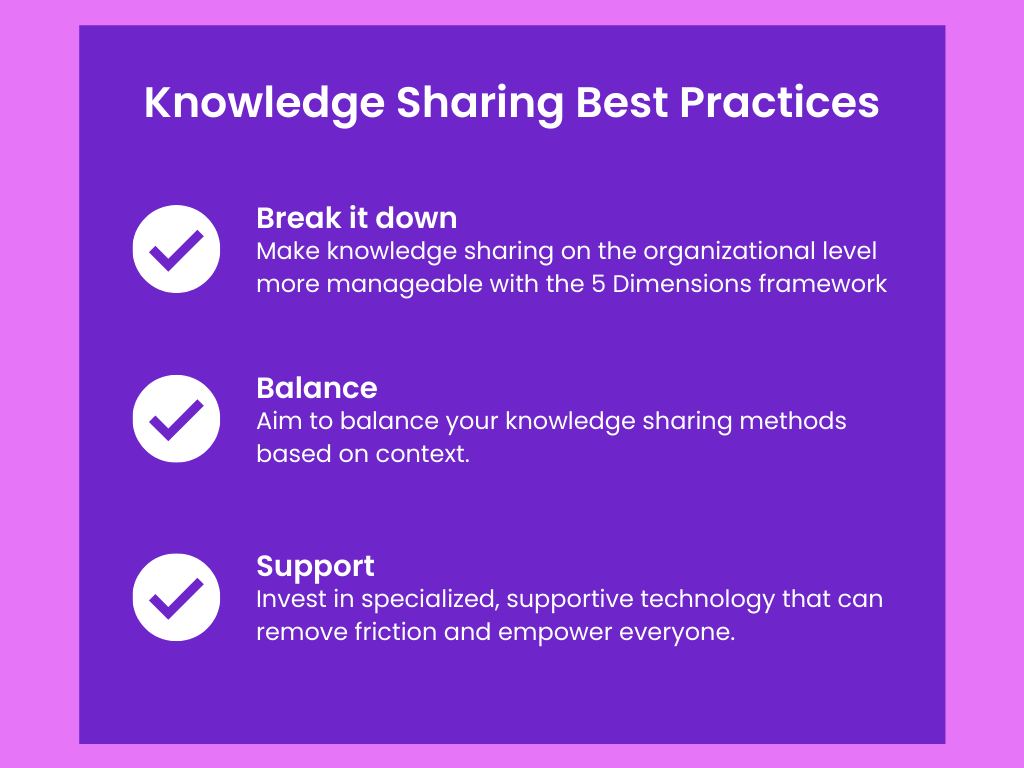
The power of knowledge sharing
When done right, knowledge sharing can be an incredibly powerful way to enhance productivity, improve collaboration, speed up decision making, reduce organizational memory loss, maximize the value you get from your company knowledge, and get closer to your customers.
And while walking the thin line between knowledge silos and information overload can be difficult, the technology available today makes it easier than ever.
Whether your organization is just starting or deep into your knowledge sharing journey, there is one thing you should always remember:
The knowledge your company needs to generate your most groundbreaking ideas likely already exists–it's just waiting to be shared.


.png?width=1200&name=2021%20Blog%20CTAs%20(7).png)


